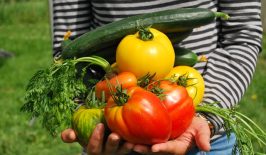Dried Leaves in Your Garden
As mulch: Leaves make excellent mulch for use with your home grown balcony plants (flowering or show plants). They help lessen the growth of weeds, retain soil moisture, maintain lower soil temperatures in the summer, protect against temperature fluctuations and some types of low temperature harm during winter. They eventually decompose, adding their nutrients to the soil and improving soil structure.
In your compost: They also make a good addition to your compost pile. Leaves are difficult to compost alone and will require extra nitrogen in the form of a commercial fertiliser (any good manure can be added to the leaves), or materials high in nitrogen such as grass clippings.
Leaves prone to diseases like those of the apple scab, anthracnose, or those infected with leaf spots should be removed or destroyed to prevent over-wintering of the disease organisms in the debris and possible re-infection of new leaves.
Even the floral offerings to gods in most houses when dry add to the making of good mulch. Maintaining the flowers in a plastic bag or container is not a smelly affair or a cumbersome process. Pressing down with your hand over the top once every two days helps push the decomposed flowers down and reduce the load.
Shredding is not required but it may speed their rate of decomposition. The decision to shred the leaves for composting is of individual preference and related to the convenience of the person in charge.
You can make your own mulch by shredding leaves, sticks, grass, compost and other organic material. By doing this instead of throwing the material out with the trash, you’re recycling and saving the environment from more landfills.
Some Tips for Plant Lovers
A guiding thought which I feel is important for plant lovers is that unless you have a lot of space to let the bougainvillea grow wild, bougainvillea will need periodic trimming. Don’t be afraid to trim it. Be careful when pruning your bougainvillea plants. They have thorns and aren’t easy to handle.
Bamboo can be beautiful. But most bamboos take a long time to grow. The leaves dry fast and fall off. So if you have it in the balcony, be ready to have a weekly session of cleaning the dried leaves. Care for them also includes restricting its height. It can be controlled by cutting it above the nodes. Bamboo shoots sometimes extend till the ceilings of houses. In such cases, cut out the stalk from the uppermost branch. If lower stems have less or no branches, then cut it from its lower half and reduce the branches till second node of every branch. This encourages the growth growing of new, tender branches.
Authour: The Alternative. The Alternative is an online media publication focused on sustainable living and social impact. Republished here with permission.





